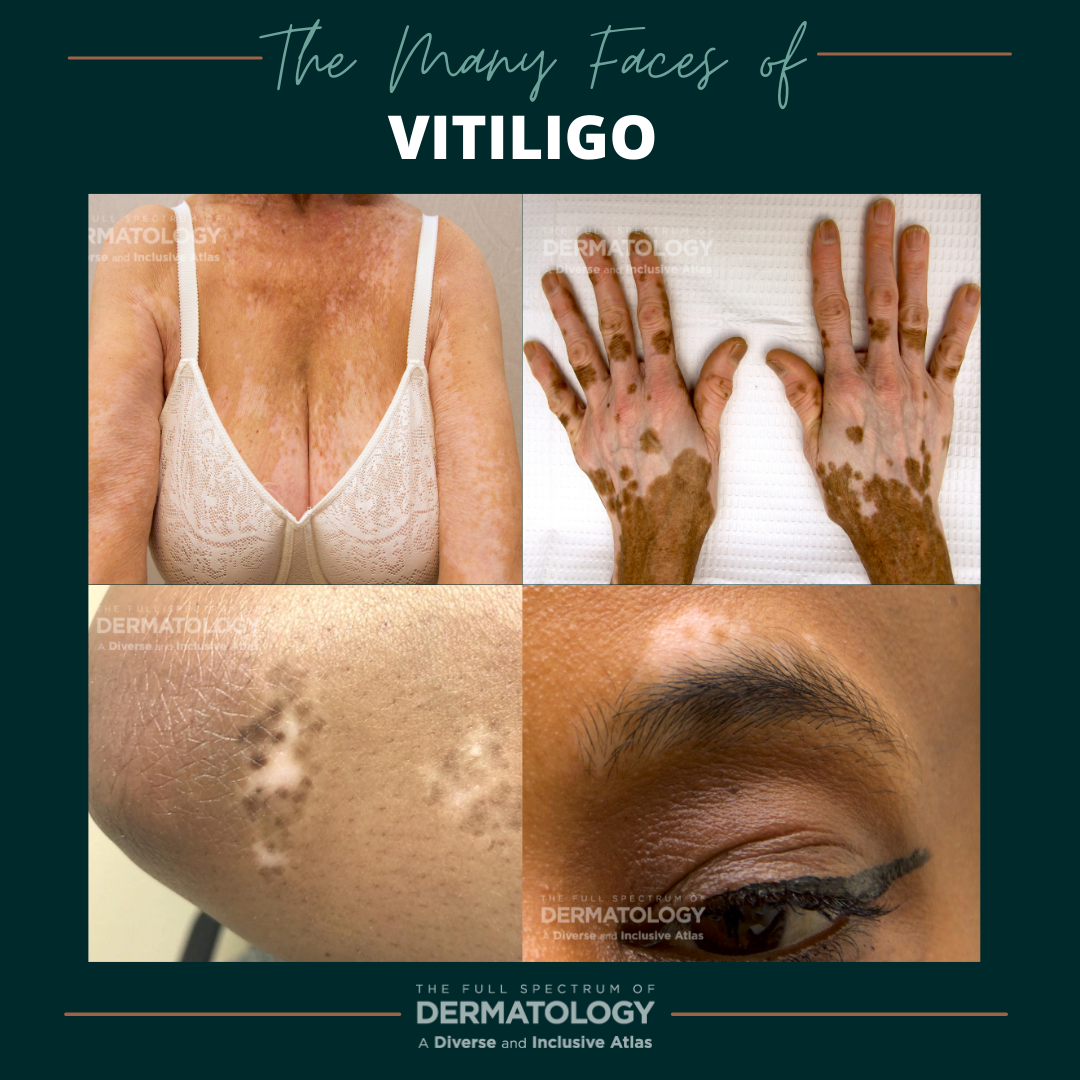Our new series, “The Many Faces of”, showcases side-by-side images of some of the most commonly seen dermatology conditions in an array of skin tones and briefly highlight nuances in clinical presentation. All images featured in the series are part of The Full Spectrum of Dermatology: A Diverse and Inclusive Atlas, a resource developed by co-editors Misty Eleryan, MD, MS, and Adam Friedman, MD, and published by SanovaWorks and Educational Testing & Assessment Systems.
We continue our series with a look at Vitiligo, which is present in up to 2% of the global population, and though it is often easier to appreciate on darker skin types, it affects all ethnicities and genders. As you can see from the images, repigmentation often first appears as scattered pigmented dots due to the location of melanocytes within hair follicles and sweat glands.
 Vitiligo is an autoimmune condition in which the immune system causes inflammatory cells to target melanocytes and prevents them from creating melanin, thereby leading to depigmentation of the skin. Any area of the body containing melanocytes can be affected, including the skin, hair, and eyes. Genetics can play a part as well, as up to 30% of patients with vitiligo report a family history of the condition. It’s also important to screen affected patients for other autoimmune conditions, including but not limited to thyroid disease, diabetes, and connective tissue disease, as they are at an increased risk of developing other autoimmune disorders.
Vitiligo is an autoimmune condition in which the immune system causes inflammatory cells to target melanocytes and prevents them from creating melanin, thereby leading to depigmentation of the skin. Any area of the body containing melanocytes can be affected, including the skin, hair, and eyes. Genetics can play a part as well, as up to 30% of patients with vitiligo report a family history of the condition. It’s also important to screen affected patients for other autoimmune conditions, including but not limited to thyroid disease, diabetes, and connective tissue disease, as they are at an increased risk of developing other autoimmune disorders.
Treatment of vitiligo is aimed first and foremost at reducing inflammation around the melanocytes to prevent further destruction and second, triggering melanocytes to produce melanin to cause re-pigmentation of the skin. This is done with topical medications, light and/or laser therapy, and in some instances, oral treatment. In certain cases, if the body surface area affected is greater than 70-80%, some patients will instead prefer to depigment the remaining portions of the skin that contain pigment to achieve a more even skin tone. This can be done using high potency topical lightening agents.
Nuances to Highlight
Though both lighter and darker skin tones can develop vitiligo, patients with darker skin tones are often more emotionally affected by the condition due to its easier visualization on darker skin as the depigmented areas easily contrast the melanin-rich skin. When an area of the skin re-pigments (either naturally or with treatment), pigmentation is often first observed surrounding a hair follicle and looks like scattered pigment “dots.” This pattern is seen in all skin tones, though it is often easier to visualize in darker skin types, again due to the contrast between dark and light skin colors.
It is important to educate ALL vitiligo patients about the importance of increased sun protection, as the areas without pigment are at increased risk of sun damage and burn. Sun protective behaviors include using a high strength – (i.e. spf 50+ or higher) mineral based sunscreen with frequent re-application every 2 hours when outdoors, wearing sun-protective clothing, and minimizing being out in the sun during peak sunlight hours (from 10AM-4PM).
Further Reading
If you would like to learn more about diagnosing and treating vitiligo, check out the following article: https://nextstepsinderm.com/derm-topics/current-and-emerging-management-strategies-for-vitiligo/
Acknowledgements
We thank co-editors Misty Eleryan, MD, MS, and Adam Friedman, MD for reviewing the content of this article.
Reference
Eleryan, Misty, and Adam Friedman. The Full Spectrum of Dermatology: A Diverse and Inclusive Atlas. SanovaWorks, 2021.
NOW AVAILABLE! Visit the online image gallery for The Full Spectrum of Dermatology: A Diverse and Inclusive Atlas, where you will find high-quality images that you will be able to use, free of charge, for non-commercial educational purposes. Access the online gallery here.
The Full Spectrum of Dermatology: A Diverse and Inclusive Atlas DIGITAL EDITION is available for purchase here.
Did you enjoy this article? You can find more here.


